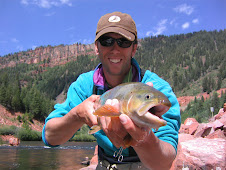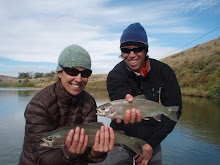Over 20 years ago, Patagonia introduced layering for the outdoors. From the original polypropylene in 1980 to the more environmentally friendly Performance Baselayers of today, we’re continually striving to set the standards for baselayer performance.
Patagonia Performance Baselayers offer two approaches to the goal of staying dry and comfortable: Capilene® polyester with recycled content or all-natural merino wool.
Baselayers - Capilene and Merino Wool
Next-to-skin baselayer is critical for angler comfort. This allows the angler to remain dry next to your skin so you avoid the effects of evaporative cooling and the clammy feeling of moisture on the skin. Worn alone in warm weather, the baselayer wicks moisture off your skin and out to the air, providing a cooling and drying effect on the skin. For those hiking in to fish and working up a sweat there are obvious benefits. For anglers standing still for long periods while fishing, the benefits of wicking ambient moisture off the skin while not wetting out are equally important. In cold weather it moves ambient moisture and sweat from exertion off the skin and into the outer layers, which in turn move it to the surface to evaporate. The Other performance benefits of Patagonia’s next-to-skin layer is quickness to dry, insulation when needed, environmentally safe odor control and ease of care (can be machine or sink washed).
UK anglers are challenged at home by the Maritime Climate with bone-chilling damp during salmon season and winter trout that slightly improves to a warmer damp in the summer months. Traveling anglers face the same myriad of climatic challenges when headed to remote destinations in South America, New Zealand, Rocky Mountains and even the tropics. To address moisture and temperature challenges, Patagonia offers two Baselayer collections with 4 specific weights.
Capilene is made from specially designed polyester fabrics that actively move moisture away from the skin when walking, standing and wading for long periods of time. For odor control, we added a naturally derived treatment called Gladiodor allowing for multi-day use between washing. Capilene 1 is designed for hot weather as it is fast-wicking, fast drying and highly breathable. Capilene 2 is for mild to cool conditions. Capilene 3 is our most versatile and popular style with its dense interior honeycomb construction that is brushed for warmth and softness. From walking the dog to taking on salmon in full conditions, this is an important style to have in your kit. Capilene 4 is warmest Capilene, featuring an inside grid pattern that disperses moisture and retains great warmth.
Our Capilene Baselayer can be recycled through our Common Threads Recycling Program. When your Capilene is no longer usable, send it back and we melt down these garments to create new polyester fibers for future clothing. This keeps worn garments out of landfills.
Merino Wool
Wool has long been popular for anglers with is inherent ability to remain warm when wet and resistant to odor. A quantum leap by 3 ranches in New Zealand produces special fine-gauge yarn fiber that is 18.5 micron fineness, one-fifth the thickness of a human hair that actually can wick moisture. Using Patagonia’s slow wash process instead of using the environmentally damaging chlorine to remove the hard scales, we are confident that this is the best 100% Merino Wool Baselayer that manages moisture, is incredibly soft against the skin, naturally odor resistant and is machine washable. We developed Wool 1-4 weights like Capilene, with Wool 1 being the lightest. Wool 2 best suited for use in warm to cool conditions. Wool 3 best suited for active, cold conditions. And Wool 4 for coldest conditions and styled for outerwear for even greater variety of uses.
Way too much of what is made these days ends up in the trash at the end of its useful life. At Patagonia, we're working to change that.
In 2005 we launched our Common Threads Garment Recycling Program, through which customers could return their worn out Capilene® Performance Baselayers to us for recycling. We've since been able to expand the list of recyclable garments to include worn out Patagonia® fleece, Polartec® fleece clothing (from any maker), Patagonia cotton T-shirts, and now some additional polyester and nylon 6 products that come with a Common Threads tag.
Through Common Threads we can transform your unusable garments into new clothing, which gets us closer to a long-standing company goal of taking full responsibility for every product we make.
How to Recycle
Recycling old Patagonia garments is easy. Simply wash them first and use one of the following collection methods:
1. Mail them to the Patagonia Service Center at
Patagonia Service Center
ATTN: Common Threads Recycling Program
8550 White Fir Street
Reno, NV 89523-8939
2. Drop them off at the Patagonia Retail Store nearest you or at one of our Performance Baselayer Dealers – ideally, while you're running other errands, to reduce environmental impact.
Please note: Recycling your old clothes is voluntary. If you choose to recycle, you'll gain the satisfaction of knowing that your old polyester garments will not end up in a landfill or an incinerator, and that future Patagonia products will require significantly less virgin polyester (less oil) than products from seasons past.




